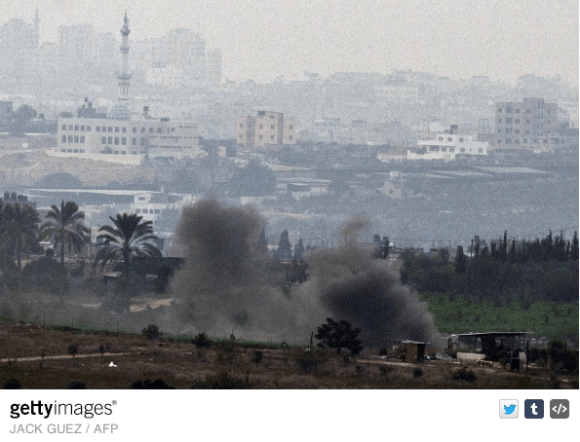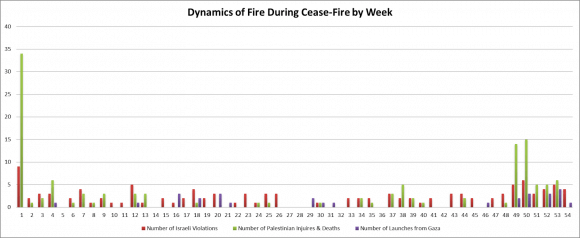
The immediate cause of the latest round of fighting in the Gaza Strip, which featured rockets and mortars fired into Israel and air attacks on the coastal enclave, occurred over the last two days. But the roots of the latest fighting are Israeli violations of the November 2012 truce between Hamas and Israel, and the years-long blockade and occupation crippling the Gaza Strip.
Yesterday, the Palestinian militant group Islamic Jihad attacked Israeli soldiers said to be advancing towards the Gaza Strip. In response, an Israeli airstrike killed three fighters. That, in turn, caused Islamic Jihad to unleash a barrage of some 70 projectiles into southern Israeli communities. No injures in Israel have been reported.
The Palestinian group said that its attacks were a way to avenge the deaths of six Palestinians killed in the West Bank and Gaza in recent days, as Allison Deger reported here.
The rockets and mortars fired into Israeli territory were the most significant Palestinian counter-attack since the end of Operation Pillar of Defense in late 2012. The Islamic Jihad attacks caused some Israeli officials to act tough, with Foreign Minister Avigdor Lieberman saying Israel needed to “reoccupy” Gaza–most likely bluster, since the Israeli military has no interest in actually doing so.
Prime Minister Benjamin Netanyahu warned that “if there won’t be quiet in the south, there will be noise in Gaza – a lot of noise, and this is an understatement.”
Sure enough, Israel reportedly launched 29 airstrikes and attacked Islamic Jihad positions with artillery. According to Ma’an News Agency, no Palestinians have been killed or injured, perhaps reflecting an Israeli intention to escalate just enough so that peace talks with the West Bank leadership continue. Islamic Jihad and Hamas also have little interest in provoking an all-out assault.
Still, even if this latest escalation doesn’t immediately break out into full-scale war, it’s one more step on the way towards that path. That’s because the Egyptian and U.S.-brokered ceasefire from 2012 between Palestinian militant groups–including Islamic Jihad and Hamas–has been threatened by repeated Israeli violations. And it’s those Israeli violations that have provoked rocket fire into Israel.
The Palestine Center’s Yousef Munayyer wrote about these dynamics last month with a chart and explanation:
Israeli cease-fire violations have been persistent throughout and have routinely resulted in Palestinian injuries and deaths. Palestinian launches have been rare and sporadic and occurred almost always after successive instances of Israeli cease-fire violations.
Munayyer also touched on the internal Palestinian political struggles over the truce:
The biggest challenge to the cease-fire agreement is persistent Israeli violation and the lack of any accountability for them. The politics of the Gaza Strip are complex. Israel says it wants Hamas to control projectile fire from other factions and yet it persistently violates the truce putting Hamas in a position of having to defend Israel’s violations. By targeting groups other than Hamas and by expecting Hamas to crack down on their responses, Israel is playing a dangerous and deadly game of divide and conquer in Gaza that will likely lead to the unraveling of the cease-fire. Once again, Israel has proven security is not its aim, subjugation is.
The Israeli attacks on Gaza are sure to weaken Hamas a little more than they have been, though it doesn’t look like this round of fighting will depose the group. Hamas is in a precarious position, reeling from the blockade as well as Egyptian efforts to crush them. Now, with Islamic Jihad and Israel trading fire, their hold on power has slipped a bit–which plays right into Israel’s hands, who want to destroy the group as a viable resistance group that can also govern.




It doesn’t matter how many Palestinians are killed…the media stenographers are going to write it up as self defense to provocation….look there a broken sidewalk, let’s bomb Gaza.
And the streams thereof shall be turned into pitch, and the dust thereof into brimstone, and the land thereof shall become burning pitch..For the LORD’S indignation is against all the nations..he hath delivered them to the slaughter..For My sword is satiated in heaven, Behold it shall descend for judgment upon Edom And upon the people whom I have devoted to destruction,
Isaiah 34
Islamic Jihad or whoever have been waiting 16 months to respond!
Making it up as you go Mr. Kane?
Any cease fire for Hamas is just a Hudna – buying them time to regroup for the next attack. Only the elimination of Israel will satisfy them. They are an enemy that can ever be placated.
Some things to remember:
1. All attacks by Palestinians are unprovoked.
2. All attacks by Israeli forces are retaliation for unprovoked attacks by Palestinians.
3. Attacks by Palestinians are random.
4. Retaliatory attacks by Israeli forces are pin-point.*
*Despite the pin-point and well-planned nature of Israeli retaliation, women and children inevitably end up dead or maimed. In this case Israeli soldiers cry and blame it on the Palestinians, because it is ALWAYS their fault.
Alex, why don’t you suggest to Allison to go down to Sderot (Israeli town being bombarded with rockets) for a few days? There is a special on with reality sandwich’s.